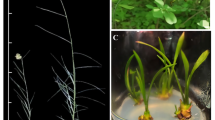Abstract
Oospores germinated in distilled water, but the addition of nutrients increased the percent germinating. A germ tube emerged which quickly elongated into a branched aseptate hypha. Germination occurred over a wide range of temperature. Germinability decreased with age of culture. The incubation temperature and the addition of cholesterol to the medium affected germination percentage. Oospores, formed in cultures on media to which cholesterol was added, were more resistant to heat and to ultraviolet radiation. Oospores survived 2 hours exposure to 50 °C. Oospores formed on mushroom compost survived 18 months at 25 °C.
Similar content being viewed by others
References
Al Hassan, K. K. &Fergus, C. L. (1969) Oospore production ofPythium artotrogus, Mycopath. et Mycol. Appl. 39:273–286.
Cochrane, V. W. (1958) Physiology of fungi. John Wiley & Sons, New York. 524 p.
Drechsler, C. (1952) Production of zoospores from germinating oospores ofPythium ultimum andPythium debaryanum. Bull. Torrey Bot. Club. 79:431–450.
Drechsler, C. (1956) Production of zoospores from germinating oospores ofPythium mamillatum Meurs.Bull. Torrey Bot. Club 83:196–206.
Fergus, C. L. &Amelung, R. M. (1971) The heat resistance of some thermophilic fungi on mushroom compost.Mycologia 63:675–679.
Fergus, C. L., Sinden, J. W., Schisler, L. C. &Sigel, E. M. (1963) Possible detrimental effect ofPythium artotrogus on the cultivated mushroom.Phytopathology 53:1360–1362.
Haskins, R. H. (1965) Sterols and temperature tolerance in the fungusPythium.Science 150:1615–1616.
Middleton, J. T. (1943) The taxonomy, host range and geographic distribution of the genusPythium.Mem. Torrey Bot. Club 20:1–171.
Robbins, W. J. &Ma, R. (1941) Biotin and the growth ofFusarium avenaceum.Bull. Torrey Bot. Club 68:446–462.
Sideris, C. P. (1932) Taxonomic studies in the family Pythiaceae. II.Pythium.Mycologia 24:14–61.
Sinden, J. W. (1971) Ecological control of pathogens and weed-molds in mushroom culture.Ann. Rev. Phytopathology 9:411–432.
Sparrow, F. K. (1931) Two new species ofPythium parasitic in green algae.Ann. Bot. n.s. 45:257–277.
Sussman, A. S. &Halvorson, H. O. (1966) Spores: their dormancy and germination. Harper & Row, Publ. New York. 354 p.
Trow, A. H. (1901) Observations on the biology and cytology ofPhythium ultimum n. sp.Ann. Bot. n.s. 15:269–312.
Winston, P. W. &Bates, D. H. (1960) Saturated solutions for the control of humidity in biological research.Ecology 41:232–237.
Author information
Authors and Affiliations
Additional information
Contribution No. 92 from the Department of Biology.
Rights and permissions
About this article
Cite this article
Al Hassan, K.K., Fergus, C.L. The effects of nutrients and environment on germination and longevity of oospores of Pythium hydnosporum. Mycopathologia et Mycologia Applicata 51, 283–297 (1973). https://doi.org/10.1007/BF02057799
Accepted:
Issue Date:
DOI: https://doi.org/10.1007/BF02057799




